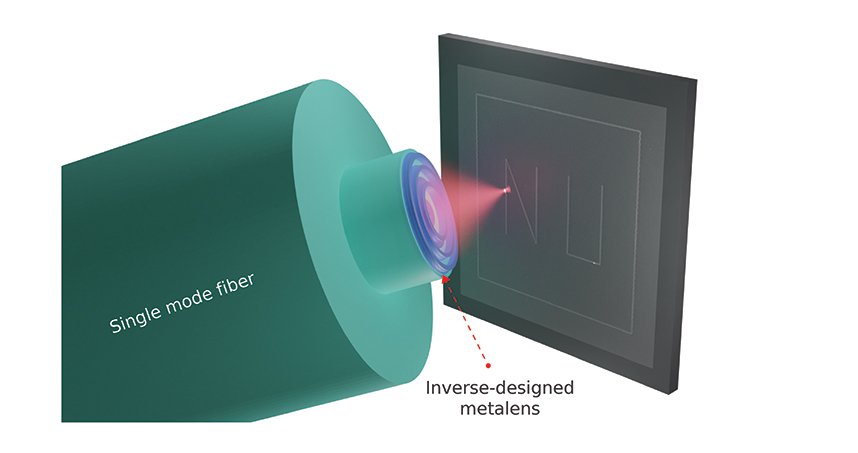Research
Novel method could lead to more efficient lenses
April 20, 2021

A lens produced by electromagnetic methods will allow researchers to print structures on challenging surfaces
Technique allows for a simpler and cost-effective alternative for various applications
Direct laser writing (DLW) is a technique to fabricate optical components. The method has its practical limitations and can be expensive to use. New work from Northwestern Engineering could lead to more advanced printing at a lower cost using a smaller device with more efficient lenses.

A collaboration between the McCormick School of Engineering’s Koray Aydin and Sridhar Krishnaswamy demonstrated that a compact, thin lens produced by electromagnetic design methods, such as inverse-design and 3D nanoprinting, will allow researchers to print and create structures on surfaces that are otherwise difficult to achieve using the conventional DLW system.
The paper “Inverse Design and 3D Printing of a Metalens on an Optical Fiber Tip for Direct Laser Lithography” was published March 15 in the journal Nano Letters. Aydin is an associate professor of electrical and computer engineering, and Krishnaswamy is a professor of mechanical engineering. Both are affiliated faculty members of the International Institute for Nanotechnology.
“Our approach is unique as we utilize both unconventional design and fabrication techniques,” Aydin said. “This allows for a simpler and cost-effective alternative for various applications, such as imaging, endoscopes, and optical nanoparticle trapping, among others.”
Unlike the conventional way of creating optical elements that starts with a well-known structure, the inverse-design method allows for an arbitrary initial guess for an optimal design. This is achieved by setting a hard constraint on the objective of the design and then searching for optimal design. Combining both the inverse-design method and two-photo polymerization allows a new alternative for fabricating complicated optical structures that are rather difficult to achieve using conventional techniques.

Aydin and Krishnaswamy, along with graduate student Wisnu Hadibrata and postdoc Heming Wei, produced a high-numerical aperture metalens that can be printed on a fiber tip. The lens uses a two-photon polymerization system, commonly known as 3D nanoprinting, which is capable of printing structures with 100 nanometer resolution.
To directly demonstrate their work, Aydin and Krishnaswamy built a homemade system using the fabricated metalens, showing that its effectiveness is comparable to bulky glass lenses.
“We effectively reduced the lens size by four orders of magnitude while preserving the same efficiency,” Aydin said. “This enables us to do 3D printing at the nanoscales using a fiber-tip metalens and opens up new opportunities for different and more complicated shapes.”
“Imagine being able to bring several of these optical fiber-tip metalenses along different directions to enable simultaneous 3D printing from multiple angles,” Krishnaswamy said. “That is something we cannot do today because of the bulky lenses typically used.”
A provisional patent has been submitted. The research is funded by the Office of Naval Research through their Young Investigator Program and Division 332 S&T grants.